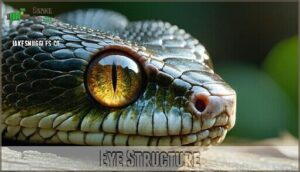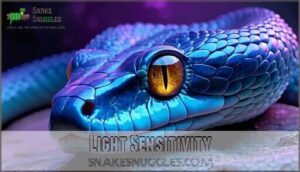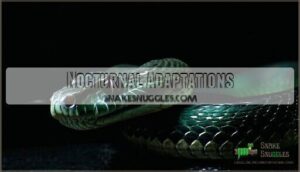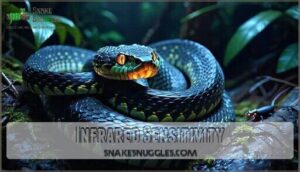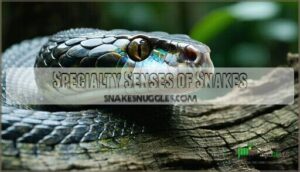This site is supported by our readers. We may earn a commission, at no cost to you, if you purchase through links.
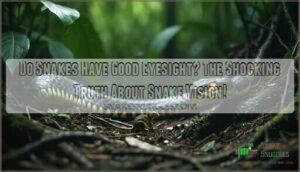
When you’re wondering "do snakes have good eyesight," the answer depends on the species and situation. Daytime hunters like coachwhips see better than nocturnal species, but even they can’t match human vision clarity.
However, snakes make up for blurry sight with incredible movement detection and specialized adaptations. Many species have heat-sensing abilities that let them "see" warm-blooded prey as glowing targets against cooler backgrounds.
It’s like having thermal goggles built right in. Their unique combination of limited vision plus extraordinary supplementary senses creates the perfect hunting toolkit.
Table Of Contents
- Key Takeaways
- Do Snakes Have Good Eyesight?
- Snake Vision Basics
- Snake Vision in Bright Conditions
- Snake Vision in Darkness
- Comparison With Human Vision
- Specialty Senses of Snakes
- Frequently Asked Questions (FAQs)
- How good is snakes’ vision?
- Can a snake see a person?
- What does the vision of a snake look like?
- Can snakes see in the dark?
- Do snakes have good night vision?
- How does snake vision compare to other reptiles?
- Can snakes see in complete darkness?
- Do snakes have better vision than humans?
- How do snakes see without eyelids?
- Can snakes see underwater while swimming?
- Conclusion
Key Takeaways
- You’ll find that most snakes don’t have sharp eyesight like humans – they’re more like that friend squinting without glasses, seeing only two primary colors and focusing on movement rather than fine details.
- You can’t rely on snakes having good night vision since most struggle in complete darkness, but some species like pit vipers use heat-sensing pits to "see" warm-blooded prey as glowing targets against cooler backgrounds.
- You’ll discover that snakes compensate for poor vision with incredible specialty senses – they detect tiny ground vibrations through their jawbones, use tongue flicking to collect scent molecules, and possess thermal imaging abilities that work like built-in night vision goggles.
- You shouldn’t underestimate snake vision capabilities since they’ve evolved UV detection abilities and enhanced movement tracking that creates a sensory superpower system perfectly adapted for survival, even if they can’t match human visual clarity.
Do Snakes Have Good Eyesight?
Most snakes don’t have particularly good eyesight compared to humans.
Their visual acuity and depth perception are limited, though species variation plays a big role.
Snake vision quality focuses more on detecting movement than sharp details.
However, snake eyesight isn’t terrible—it’s just adapted differently.
Their eye protection and color vision serve specific survival needs rather than crystal-clear sight.
Some species also possess infrared detection abilities using specialized pit organs.
Snake Vision Basics
You might think snakes can’t see much, but their eyes actually work quite differently from yours.
While snakes may not see the world like we do, their unique vision is perfectly adapted for survival in ways that might surprise you.
While they can’t spot fine details like you do, snake eyes contain specialized structures that help them detect movement and changes in light better than most people realize.
Eye Structure
Understanding how snakes see starts with their unique eye anatomy.
You’ll notice their spherical lens creates sharper focus than human eyes, perfect for tracking swift movements.
The retinal structure differs too – cone distribution varies by species, affecting color perception.
Without eyelids, snakes rely on a transparent scale called a spectacle for protection.
Here’s where it gets interesting: spectacle bloodflow actually cycles during rest, preventing blood cells from blocking vision.
This snake eye structure shows how evolution shaped snake eyesight for survival, not sharp detail like yours.
Snakes have adapted to their environment, even developing infrared detection abilities for hunting.
Light Sensitivity
Beyond their unique eye structure, you’ll find that snake vision operates on a completely different light spectrum than yours.
Their photoreceptor types create spectral sensitivity that extends into ultraviolet ranges, giving them superpowers you can’t imagine. Visual pigments in snake eyes detect light wavelengths invisible to humans, while their light adaptation helps them excel in various conditions.
Here’s what makes snake eye function so remarkable:
- UV detection – They see ultraviolet light that’s completely invisible to you
- Enhanced contrast – Lightdark contrast appears much sharper in their vision
- Dual adaptation – Snakes and light work together for both day and snake night vision
- Specialized pigments – Three visual pigments create their unique dichromatic world
Snake Vision in Bright Conditions
You might think snakes struggle to see clearly when the sun’s blazing overhead, but many species actually perform better in bright daylight than you’d expect.
Day-hunting snakes have developed special UV-filtering layers in their eyes that sharpen their vision and help them spot prey with surprising accuracy during sunny conditions.
Daytime Vision
When you think about snake visual acuity during daylight hours, you’ll discover they’re surprisingly capable hunters.
Dayhunting snakes like vine snakes have developed specialized adaptations that make them effective predators when the sun’s out.
Here’s how snake color vision works in bright conditions:
- Enhanced Visual Acuity: Day-active species possess higher cone density in their retinas, giving them sharper focus for movement detection during hunting strategies.
- Color Spectrum Processing: These snakes see well enough to distinguish between different wavelengths, though their color vision differs substantially from humans.
- Predator Evasion Advantages: Clear daytime vision helps them spot threats and navigate their environment with confidence.
Diurnal snakes often have lenses that provide UV-filtering capabilities, enhancing their vision.
UV Light Sensitivity
Daylight hunting brings another surprise – you’ll discover that snake vision extends beyond what your eyes can see.
Many species possess remarkable UV perception abilities that give them a serious evolutionary advantage in the visual spectrum game.
Here’s what’s fascinating: snakes can detect ultraviolet light through specialized photoreceptors in both their primary eyes and a unique parietal eye.
This UV sensitivity isn’t just a neat trick – it’s vital for prey detection and survival strategies.
Some species like Helicops can actually express four different visual pigments simultaneously, including two distinct types for processing ultraviolet light.
Notably, research indicates that juveniles show higher reflectance compared to adults.
However, snake color perception works differently during diurnal activity.
Their natural UV filters help balance this sensitivity, preventing overexposure while maintaining their ability to spot hidden UV patterns that many prey animals display.
Snake Vision in Darkness
You might think snakes can’t see well in the dark, but they’ve got some incredible tricks up their scaly sleeves.
Many snakes actually perform better in low-light conditions than during bright daylight, thanks to specialized retinal structures and heat-sensing abilities that work like natural night vision goggles.
Nocturnal Adaptations
The darkness transforms how you’ll witness snake vision in action.
When night falls, snakes become masters of low-light vision, relying on specialized adaptations that put human night vision to shame.
Their eyes contain more rod cells than cone cells, making them incredibly sensitive to even the faintest light sources.
Nocturnal species have evolved remarkable abilities that integrate multiple senses:
- Enhanced retinal structures that amplify available light for better navigation
- Specialized lens configurations that maximize light capture in dim conditions
- Advanced sensory integration that combines visual cues with other detection methods
You’ll find that snakes don’t just see better in darkness—they experience it differently.
Some researchers even use specialized scopes to study them.
Their snake vision processes movement and contrast with exceptional clarity, while their eyes work alongside heat detection systems for thorough environmental awareness.
This combination makes nocturnal species incredibly effective hunters, turning the cover of darkness into their greatest advantage for survival and infrared hunting success.
Infrared Sensitivity
Three specialized snake families have mastered the art of thermal hunting through sophisticated pit organ function.
These remarkable reptiles have turned darkness into their ultimate hunting advantage through evolutionary mastery.
You’ll find these incredible organs between their eyes and nostrils, detecting infrared radiation from warm-blooded prey with pinpoint accuracy.
Here’s how snakes use thermal sensing to dominate nighttime hunting:
- Infrared hunting range extends up to one meter, allowing precise strikes at hidden prey
- Thermal image processing creates detailed heat maps in complete darkness through specialized neurons
- Prey heat signature detection works even when animals hide in cool burrows or thick vegetation
- Environmental temperature effects don’t interfere—snakes detect 0.003°C differences through thermal radiation sensitivity
These capabilities mirror the functionality of an infrared detection device.
Comparison With Human Vision
You might think your eyesight is nothing special, but compared to most snakes, you’re practically seeing the world in high definition.
While you can distinguish millions of colors thanks to three types of cone cells in your eyes, snakes typically see only two primary colors and rely more on detecting movement than sharp details.
Rods and Cones
Inside your eye and a snake’s eye, tiny cells called photoreceptors work like nature’s cameras.
You’ve got both rod cells for dim light and cone cells for bright conditions, but snakes tell a different story.
Their retinal structure relies heavily on cone cells, creating dichromatic vision that’s quite limited compared to yours.
| Vision Feature | Humans | Snakes |
|---|---|---|
| Rod Cells | Abundant | Few/Absent |
| Cone Cells | Present | Dominant |
This photoreceptor distribution gives snakes decent low-light vision and some ultraviolet light detection, but their color sensitivity can’t match your visual superpowers.
Snakes also use infrared detection through their pit organs.
Color Perception
Understanding how rods and cones work gives us insight into snake color perception, which operates quite differently from yours. You see the world through three types of cone cells, creating rich, vibrant colors. Snakes, however, live in a dichromatic vision world with only two cone types.
Think of it like comparing a full paint palette to a limited one. While you enjoy millions of color combinations, snakes work with a limited spectrum focusing primarily on blue-green colors. Their visual opsins detect short and long wavelengths, but they miss the middle range entirely.
Here’s how snake and human color perception compare:
| Vision Type | Cone Cells | Color Range | Special Abilities |
|---|---|---|---|
| Human | 3 types | Full spectrum | Excellent detail |
| Snake | 2 types | Blue-green focus | UV detection |
| Comparison | Limited | Restricted palette | Heat sensing |
Despite this colorblindness, snakes aren’t disadvantaged. Their dichromatic vision pairs with ultraviolet vision capabilities, letting them see primary colors you can’t. They’ve traded colorful detail for survival advantages like detecting warm prey in complete darkness.
Specialty Senses of Snakes
While you might think snakes are practically blind, they’ve actually developed incredible specialty senses that make up for their limited eyesight.
You’ll be amazed to learn how these remarkable reptiles use heat detection, super-sensitive smell, and vibration sensing to navigate their world with surprising precision.
Infrared Detection
Beyond their basic eyesight, you’ll discover that certain snakes possess remarkable infrared detection abilities through specialized pit organs.
These heat-sensing structures work like biological thermal imaging cameras, giving snakes incredible advantages:
- Nocturnal hunting becomes effortless as they track warm-blooded prey in complete darkness
- Heat signatures reveal hidden animals behind vegetation or rocks
- Thermal vision creates detailed temperature maps of their surroundings
Sense of Smell
You’ll be amazed by how snakes smell without noses.
Scent tracking happens through constant tongue flicking, collecting scent molecules from air and ground.
Their tongues deliver these chemical signals to the Jacobson’s organ – specialized scent receptors on their mouth’s roof.
This incredible olfactory sense creates detailed scent trails for prey detection, making snakes exceptional hunters through scent detection alone.
Vibration Detection
Through their jawbones, snakes detect the tiniest ground vibrations with incredible precision.
Their vibrational sensitivity transforms them into living seismic detectors, picking up vibrational stimuli from approaching prey or threats.
Here’s how vibration detection works:
- Ground Awareness – Specialized jaw receptors sense minute tremors
- Prey Detection – Mouse footsteps become detectable dinner bells
- Predator Avoidance – Early warning system for incoming dangers
- Sensory Integration – Combines with smell and heat detection
- Substrate Sensitivity – Adapts to different ground types
Frequently Asked Questions (FAQs)
How good is snakes’ vision?
Snakes don’t have great eyesight compared to humans.
They see only two primary colors and focus mainly on detecting movement rather than sharp details.
However, they compensate with excellent heat detection and vibration sensing abilities.
Can a snake see a person?
Yes, you can definitely be seen by a snake, though not with crystal clarity.
They’ll detect your movement, body heat, and general shape rather than fine details like your facial features or clothing patterns.
What does the vision of a snake look like?
Unlike your sharp HD vision, you’d see a blurry world through snake eyes.
They detect movement and basic shapes in blue-green tones, but can’t make out fine details or bright colors.
Can snakes see in the dark?
Most species can’t see well in complete darkness, but they’ve got a clever workaround.
Night-hunting snakes use heat-sensing pits and enhanced low-light vision to track warm-blooded prey when you can’t see them.
Do snakes have good night vision?
Forget Hollywood’s super-snake myths! You’ll find most snakes actually struggle with night vision.
They’re dichromatic, seeing only blue-green colors poorly.
However, some species like pit vipers use heat-sensing abilities to "see" warm prey in darkness, which is a key aspect of their hunting strategy, utilizing night vision alternatives.
How does snake vision compare to other reptiles?
Snakes generally have poorer vision than most other reptiles like lizards and turtles.
You’ll find they rely more on heat detection, vibrations, and smell, while lizards typically possess sharper eyesight and better color discrimination, which can be considered as better color.
Can snakes see in complete darkness?
Complete darkness isn’t a problem for many snakes.
You’d be amazed—they’ve got thermal "superpowers" that let them hunt warm-blooded prey even when it’s pitch black, using heat-sensing pits instead of relying on their eyes.
Do snakes have better vision than humans?
No, you shouldn’t expect snakes to have better vision than humans.
Most snakes see only two primary colors compared to your three, and they rely more on heat detection and vibrations for survival.
How do snakes see without eyelids?
Incredibly, snakes have transparent scales called spectacles covering their eyes instead of eyelids.
You’ll find these protective "eye caps" shed with their skin, while cyclic blood flow prevents vision obstruction during rest periods.
Can snakes see underwater while swimming?
When you spot a snake swimming, it can see underwater but not clearly.
Water distorts their already limited vision, so they rely more on vibrations and chemical cues to navigate and hunt effectively.
Conclusion
Surprisingly, when people ask "do snakes have good eyesight," the answer isn’t simply yes or no.
These incredible creatures have traded crystal-clear vision for something far more extraordinary.
While they can’t read street signs like you can, their combination of movement detection, heat-sensing abilities, and vibration awareness creates a sensory superpower that puts human senses to shame.
You’re witnessing millions of years of evolution crafting the ultimate predator detection system.
- https://snaketypes.com/how-do-snakes-see/
- https://en.wikipedia.org/wiki/Snake
- https://timesofindia.indiatimes.com/etimes/trending/how-do-snakes-see-discover-the-fascinating-truth-behind-their-vision/articleshow/120527402.cms
- https://www.nhm.ac.uk/discover/news/2016/september/study-sheds-light-on-snake-vision.html
- https://enviroliteracy.org/animals/what-is-snakes-vision-like/

